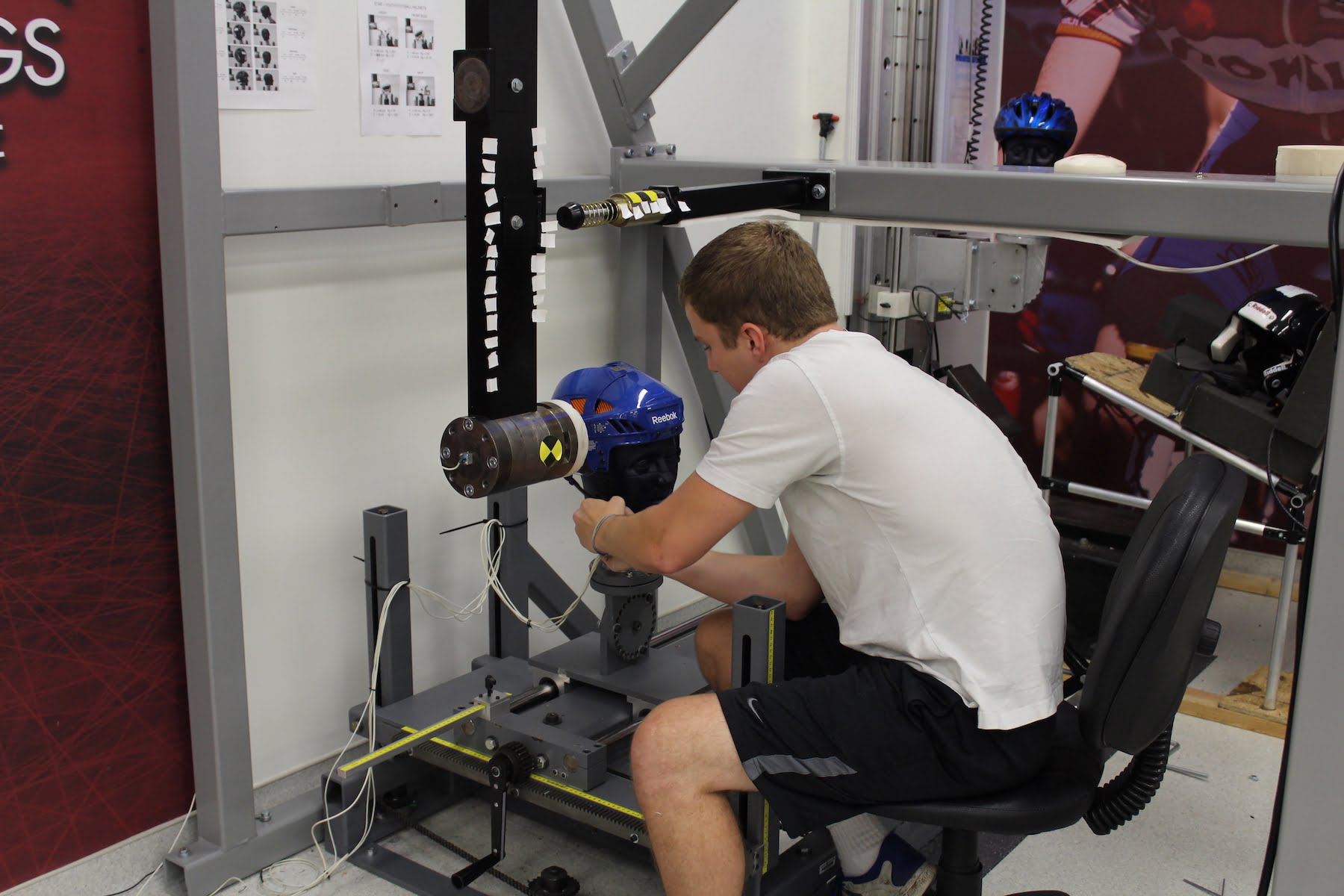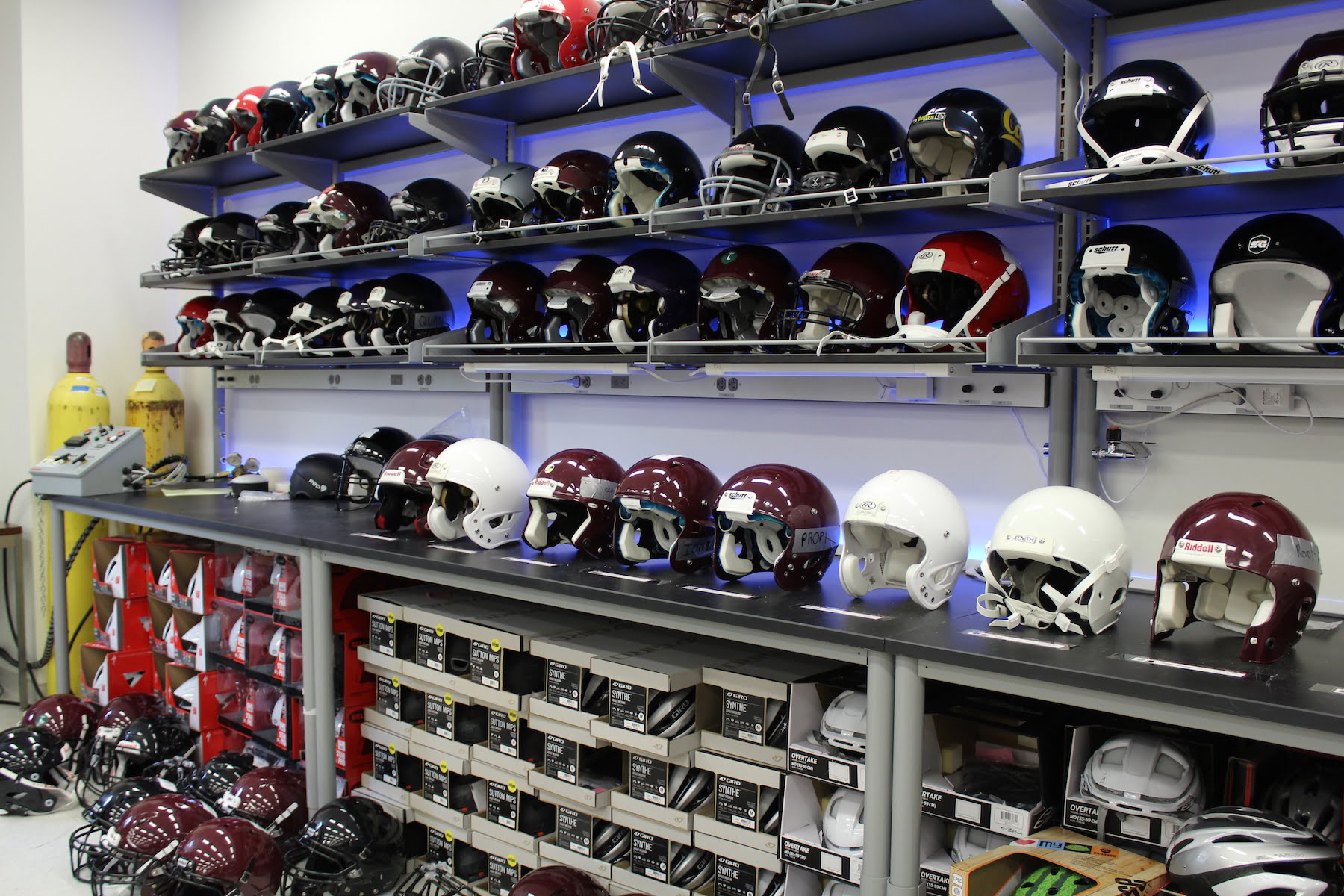
A Virginia Tech research assistant places a football helmet into a specially-designed impact machine during a recent test to determine how the helmet protects players from head injuries.
Three research assistants step up to a machine that looks like something out of medieval times. A football helmet is placed on a holder, and with the push of a button, a gigantic hammer makes impact at an unbelievable rate.
The event is normal at Virginia Tech’s Department of Biomedical Engineering and Mechanics in a lab that was designed just for the study of football helmets. From the research, researchers have developed a STAR evaluation system that rates how “safe” each helmet is.
A total of 26 adult football helmet models that have been evaluated by Tech using a STAR evaluation system. When you walk into the research lab, cut outs of those same helmets line the walls.
This Blacksburg research is taking the lead for youth recreation leagues, high schools and colleges around the country with many of the organizers at each level buying their helmets because of it.
Dr. Stefan Duma, the Harry C. Wyatt Professor of Engineering and founder of the Virginia Tech-Wake Forest Center for Injury Biomechanics, heads up the research.
“We’re doing what we can to reduce the risks for players at all levels,” he said.
The rating system is simple, according to Duma, helmets with more stars provide a reduction in concussion risk compared to helmets with less stars. Group rankings are differentiated by pre-determined thresholds.
This work has been going on since 2011 and in many ways has revolutionized the way sports now looks at concussions and head injuries.
An estimated 3.8 million sports concussions were reported in 2012, double what was reported in 2002. Those numbers also show that an estimated 5.3 million Americans live with a traumatic brain injury-related disability.
While it’s impossible to eliminate all risk of brain injury in sports, but the type of research that is taking place at Virginia Tech is helping to minimize the harm.
The helmet ratings have been a culmination of all the research on head impacts in sports and identify which helmets best reduce concussion risk.
During this time, G-forces have been produced from that “hammer machine” which imitates what players are experiencing on the gridiron.
The breakdown shows that an individual will experience a G-force of 4 G’s just by sneezing, 20 G in a pillow fight, and 40 G when heading a soccer ball. The alert zone for a possible concussion has been estimated at 98 G’s.
Through a series of impact tests, helmets are evaluated using two fundamental concepts: 1) each test is weighted based on how frequently players experience them and 2) helmets that lower head acceleration reduce concussion risk. The impact conditions and weightings are sport-specific, and inclusive of the broad range of head impacts that athletes are likely to experience.

Two years ago, the study added hockey helmets. Last year, lacrosse began part of the research, and recently bicycle helmets were added.
Of course, none of these helmets are concussion-proof. Duma said the helmet ratings identify the helmets that best reduce your chances of sustaining a concussion.
The research has also led to rule changes and coaching proper techniques that are reducing high-risk head impacts.
The cut outs of helmets on the wall include Stars showing which helmet that is able to sustain the same impact over and over. Duma also hopes to expand it to include equestrian.
He feels bicycle helmets could be more important as people are wearing and using them worldwide.
“In many cases, helmets of all kinds are being sold in retailers and some are inexpensive. The question is whether how safe are they. I hope our research will solve some of that mystery,” Duma said. “In football, it’s different. Trained professionals pick out the helmets, but in the other cases, the public is picking out their own helmets.”
Those purchases, Duma said, include bicycle helmets.
His ultimate hope is that a sticker can be added to helmets of all types which lists Tech ratings.
“I envision a sticker being placed on the helmet that states their rating and how safe we have ruled they are,” he said.
Back to football helmets, Duma said as many as 120 tests are done on each helmet, and the idea behind it are rooted in a Virginia Tech equipment manager who asked Duma his recommendation on what to buy for the Hokies.
Editor’s note: When we pick up the story next time, we will examine how the research is involving local youth football teams and the impact those players are sustaining during practice and games.




